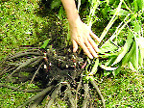
Volume XVII, Issue 41 # October 8 - October 14, 2009
|
 |
|
The Bay Gardener
 by Dr. Frank Gouin |
You Can’t Force a Peony to Flower
Give a plant what it wants and it will give you what you want
Peonies are a popular perennial that give many gardeners problems. Many problems come from how they’re planted: either too deep or in poorly drained soils.

![]() Peonies are very particular as to where they grow. In general, they prefer a well-drained loose soil rich in organic matter. If the soil has poor drainage, especially in the spring, the plant will flower poorly, and many of the flower buds will not open. This condition is known as blasting.
Peonies are very particular as to where they grow. In general, they prefer a well-drained loose soil rich in organic matter. If the soil has poor drainage, especially in the spring, the plant will flower poorly, and many of the flower buds will not open. This condition is known as blasting.
Blasting can be solved by either moving the plants to a better location or establishing a raised bed. A gardener to whom I made that suggestion last year at this time made a raised bed using a tractor tire. Simply raising the height of the soil by a few inches made a big difference.
Another thing peonies don’t like is to be planted deep. Placing more than an inch of soil over the flowering bud, often referred to as the eye, will prevent the plant from flowering. When I plant peonies, I like to see the tip of that fat flower bud at the soil surface to assure proper planting depth. Covering the bud with an inch of compost will provide adequate protection and assure flowering.
Don’t over fertilize peonies if you want them to flower. I once saw a clump of peonies at least three feet tall without a single flower. The owner informed me that he had been spreading a couple of cups of 10-6-4 fertilizer over the planting for the past four years. The foliage was lush and big, but the plant had stopped flowering. Repeated applications of high-nitrogen fertilizers will often suppress flowering by promoting excessive amounts of vegetative growth.
Peonies flower poorly for two other reasons: crowding and shading. If yours have either problem, move them now.
Peonies are picky, but if you give them what they like, they’ll give you May flowers.
Controlling Fall Web Worms
Q This question came in person, from a Deale Farmers’ Market shopper who brought a forked poplar branch covered with a dense web containing a large population of fall webworms. He wanted to know if the Eastern tent caterpillar had changed its season from spring to fall.
A The fall webworm makes its appearance August through September. The worms are much smaller and different looking than Eastern tent caterpillars. They feed on almost any species of shrub or tree.
Up to about one inch long, they can easily be controlled by spraying the foliage surrounding the web with a Bt spray such as Dipel. Spray in late evening or early morning when the caterpillars are home from feeding.
Larger caterpillars can be controlled only by spraying the insecticide Sevin, carefully following directions.
In either case, spray only the vegetation nearest the nest. The web covering the nest provides almost 100 percent protection from sprays because it repels water.
Never torch the nest. Fire will kill the branch and likely rain globs of burning dead leaves from the nest, potentially starting a brush fire.